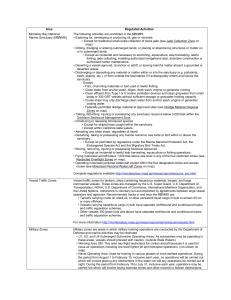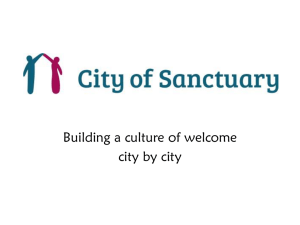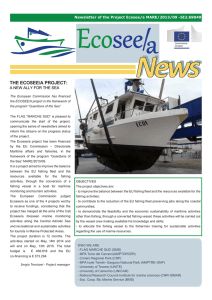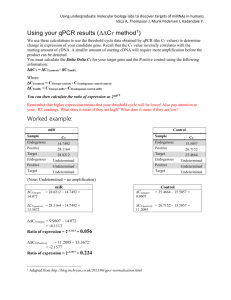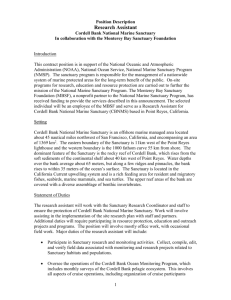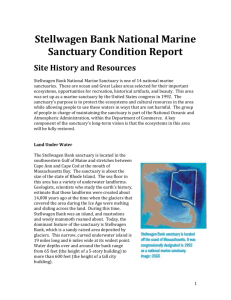12:15 Causey B - 12th International Coral Reef Symposium
advertisement
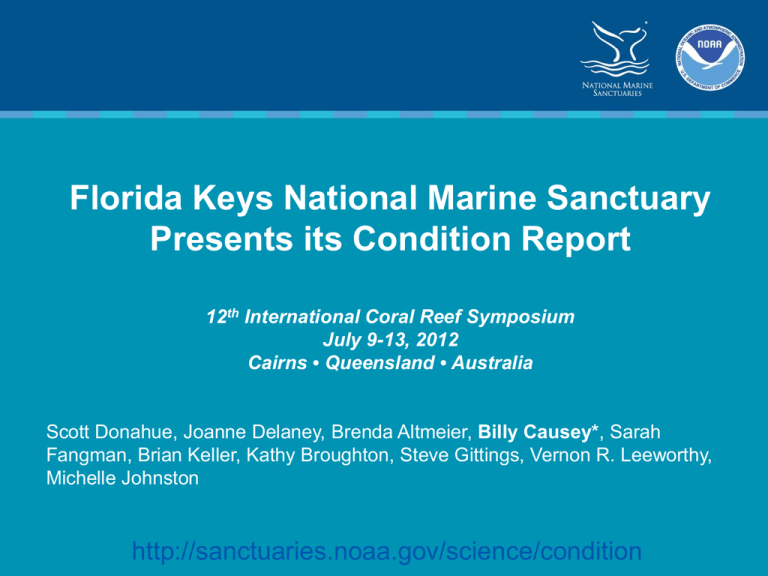
Florida Keys National Marine Sanctuary Presents its Condition Report 12th International Coral Reef Symposium July 9-13, 2012 Cairns • Queensland • Australia Scott Donahue, Joanne Delaney, Brenda Altmeier, Billy Causey*, Sarah Fangman, Brian Keller, Kathy Broughton, Steve Gittings, Vernon R. Leeworthy, Michelle Johnston http://sanctuaries.noaa.gov/science/condition Florida Keys National Marine Sanctuary and Protection Act - 1990 (Passed By United States Congress) • 2900 nm2 / 9800 km2 • Jurisdiction to mean high tide • Surrounds Florida Keys • Co-trustee Management with State of Florida • 60% State Waters • 40% Federal Waters • Management Plan implemented in 1997 • 1600 Keys / 1800 miles of shoreline N W E S 60 0 60 120 Miles System-Wide Monitoring (SWiM) “A Monitoring Framework for the National Marine Sanctuary System” • Consistent approach to design and reporting • Tailored local monitoring to track resource and human use trends Why Condition Reports? General Details - Executive-level summary - 17 questions standard among all sanctuaries - Workshops with experts to answer questions - Formal review process - Revisited prior to Management Plan updates (~ 5 years) 17 Standard Questions 1 2 Are specific or multiple stressors, including changing oceanographic and atmospheric conditions, affecting water quality? What is the eutrophic condition of sanctuary waters and how is it changing? 3 Do sanctuary waters pose risks to human health? 4 What are the levels of human activities that may influence water quality and how are they changing? 5 6 What is the abundance and distribution of major habitat types and how is it changing? What is the condition of biologically-structured habitats and how is it changing? 7 What are the contaminant concentrations in sanctuary habitats and how are they changing? 8 What are the levels of human activities that may influence habitat quality and how are they changing? 9 What is the status of biodiversity and how is it changing? 10 What is the status of environmentally sustainable fishing and how is it changing? 11 What is the status of non-indigenous species and how is it changing? 12 What is the status of key species and how is it changing? 13 What is the condition or health of key species and how is it changing? 14 What are the levels of human activities that may influence living resource quality and how are they changing? 15 What is the integrity of known maritime archaeological resources and how is it changing? 16 Do known maritime archaeological resources pose an environmental hazard and is this threat changing? 17 What are the levels of human activities that may influence maritime archaeological resource quality and how are they changing? Standardized Question Ratings TRENDS: Improving to the next category ……… Not Changing Declining to the next category ▲ ▬ ……. ▼ ..... Undetermined .........…………........ Not applicable …………................. ? N/A Condition Report Layout • Overview • Site History & Resources • Pressures (Stressors & Issues) on the Sanctuary • Status & Trends (State) of Sanctuary Resources • Sanctuary’s Response to Pressures • Literature Cited • Appendices - Explanation of Questions and Process to develop report Pressures on Resources Coral Diseases Habitat Destruction Nutrients from Pollution Overfishing Intense Coastal Development Wastewater Nutrients Stormwater Runoff Massive Algal Blooms Introduction of Marine Exotics Pressures to FKNMS Resources • Point Sources of Pollution • Non-point Sources of Pollution • External Inputs • Harmful Algal Blooms • Marinas and boats • Live-Aboard Vessels • Mosquito Control • Cruise Ships • Snorkeling/SCUBA • Fishing Pressures • Coral Bleaching • Climate Change • Diseases of Marine Organisms • Coastal Development • Non-Indigenous Species • Marine Debris • Military Use • Artificial Reefs • Weather Disturbances • Poaching • Treasure Hunting • Swimming Activities ‘State’ of Water Quality GOOD STATUS: TRENDS: Improving ……… Not Changing ..... Declining Question GOOD/ FAIR ……. FAIR ▲ ▬ ▼ FAIR/ POOR POOR UNDETERMINED Undetermined .........…………........ ? Not applicable …………................. N/A Status and Trends Basis for Judgment ▼ Large-scale changes in flushing dynamics over many decades have altered many aspects of water quality; nearshore problems related to runoff and other watershed stressors; localized problems related to infrastructure. Eutrophic Condition ▬ Long-term increase in inputs from land; large, persistent phytoplankton bloom events, many of which originate outside the sanctuary but enter and injure sanctuary resources. Human Health ▬ Rating is a general assessment of “all waters” of the sanctuary, knowing that in very specific locations, the rating could be as low as “poor.” Increased frequency of HABs and periodic swim advisories. ▲ Historically, destructive activities have been widespread throughout the Florida Keys, but many recent management actions are intended to reduce threats to water quality. Stressors Human Activities ‘State’ of Habitat GOOD STATUS: TRENDS: Improving ……… Not Changing ..... Declining Question GOOD/ FAIR ……. FAIR ▲ ▬ ▼ Status and Trends — Structure ▼ Human Activities POOR UNDETERMINED Undetermined .........…………........ ? Not applicable …………................. N/A Abundance/Distribution Contaminants FAIR/ POOR Basis for Judgment In general, mangrove and benthic habitats are still present and their distribution is unchanged, with the exception of the mangrove community, which is about half of what it was historically. The addition of causeways has changed the distribution of nearshore benthic habitats in their vicinity. Loss of shallow (<10 meters) Acropora and Montastreae corals has dramatically changed shallow habitats; regional declines in coral cover since the 1970s have led to changes in coral-algal abundance patterns in most habitats; destruction of seagrass by propeller scarring; vessel grounding impacts on benthic environment; alteration of hard-bottom habitat by illegal casitas. ? Few studies, but no synthesis of information. ▼ Coastal development, highway construction, vessel groundings, overfishing, shoreline hardening, marine debris (including derelict fishing gear), treasure salvaging, increasing number of private boats, and consequences of long-term changes in land cover on nearshore habitats. ‘State’ of Living Resources GOOD STATUS: TRENDS: Improving ……… Not Changing ..... Declining Question Biodiversity Environmentally Sustainable Fishing Non-indigenous species Key species GOOD/ FAIR ……. FAIR ▲ ▬ ▼ FAIR/ POOR POOR UNDETERMINED Undetermined .........…………........ ? Not applicable …………................. N/A Status and Trends Basis for Judgment ▼ Relative abundance across a spectrum of species has been substantially altered, with the most significant being large reefbuilding corals, large-bodied fish, sea turtles, and many invertebrates, including, the long-spined sea urchin. Recovery is questionable. ? Historical effects of recreational and commercial fishing and collection of both targeted and non-targeted species; it is too early to determine ecosystem effects of new fishery regulations and new ecosystem approaches to fishery management. ▼ Several species are known to exist; lionfish have already invaded and will likely cause ecosystem level impacts; impacts of other nonindigenous species have not been studied. — Reduced abundance of selected key species including corals (many species), queen conch, long-spined sea urchin, groupers and sea turtles. ‘State’ of Living Resources (con’t) GOOD STATUS: TRENDS: Improving ……… Not Changing ..... Declining Question Health of Key Species Human Activities GOOD/ FAIR ……. FAIR ▲ ▬ ▼ FAIR/ POOR POOR UNDETERMINED Undetermined .........…………........ ? Not applicable …………................. N/A Status and Trends Basis for Judgment ▼ Hard coral and gorgonian diseases and bleaching frequency and severity have caused substantial declines over the last two decades; long-term changes in seagrass condition; disease in sea turtles; sponge die-offs; low reproduction in queen conch; cyanobacterial blooms; lost fishing gear and other marine debris impacts on marine life. — Despite the human population decrease and overall reduction in fishing in the Florida Keys since the 1990s, heavy recreational and commercial fishing pressure continues to suppress biodiversity. Vessel groundings occur regularly within the sanctuary. Annual mean number of reported petroleum and chemical spills were around 150 during that time period, with diesel fuel, motor oil, and gasoline representing 49% of these incidents collectively. Over the long term, localized direct impacts may be overwhelmed by the adverse and wide-ranging indirect effects of anthropogenic climate change resulting in sea level rise, abnormal air and water temperatures, and changing ocean chemistry. Maritime Archaeological Resources GOOD STATUS: TRENDS: Improving ……… Not Changing ..... Declining Question GOOD/ FAIR ……. FAIR ▲ ▬ ▼ FAIR/ POOR POOR UNDETERMINED Undetermined .........…………........ ? Not applicable …………................. N/A Status and Trends Basis for Judgment Integrity ▼ Resources are non-renewable and are subject to deterioration or loss resulting from looting, chemical processes, shifting sediments, marine life, fishing gear entanglement and vessel groundings (the last two are increasing in frequency). Threat to Environment — Movement of sunken vessels during storm threatens nearby resources. Human activities ▼ Reports of looting and vessel grounding cases involving potential resources are increasing. Responses to Pressures • Water Quality Protection Program • Marine Zoning • Regulations Prohibiting Discharge Sanctuary-wide • PSSA designation (2002) • Florida’s “Healthy Beaches” • MEERA • Law Enforcement • Mooring Buoys • Education and Outreach • Marine Debris Removal • Habitat Restoration • Prohibition of Mineral & Hydrocarbon Exploration • Large Ship Navigation Beacons • Permitting Program • BleachWatch • Dolphin SMART • Blue Star • Spill Preparedness Drills • Florida Reef Resilience Program Partner • Vessel Grounding Assessments and Coral Rescue • ATBA • Advanced Wastewater Treatment for Monroe County by 2015 Summary • This is the first Condition Report for the FKNMS. • The status and trends of FKNMS resources reflect it inherited a compromised ecosystem from more than a century of pressures. • There are many successes in the relatively short time frame of management. • We still have a long way to go. http://sanctuaries.noaa.gov/science/condition


